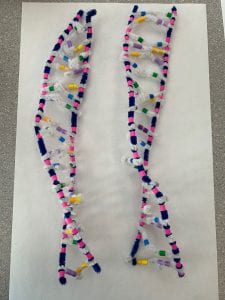DNA is made up of deoxyribose sugar whereas mRNA is made up of ribose sugar. DNA has thymine as one of the two pyrimidine bases, but mRNA has uracil which pairs up with adenine. DNA is present in the nucleus while mRNA is found mainly in the cytoplasm after synthesis. The structures differ for the backbones as DNA has two backbone and mRNA is single-stranded. mRNA is shorter than DNA because it has fewer nucleotides.
The goal of transcription is to make an RNA copy of a gene’s DNA sequence. Firstly, a specific section of DNA unwinds which exposes one gene. Then complementary RNA bases bond along one strand. The unique RNA base, uracil, bonds with adenine. Next, adjacent nucleotides form covalent bonds and build the RNA backbone. Lastly, RNA is released and DNA reforms double helix shape.
The activity was accurate in showing the process and steps of transcription. It was inaccurate though as it did not show what happens after transcription or how DNA forms back to original double helix shape.
*Note: DNA should be in double helix shape once the transcription is complete





DNA replication occurs during mitosis. DNA is replicated during the synthesis phase.
DNA replication occurs in 3 steps: unwinding, complementary base pairing and joining. Firstly, the helix unwinds and the two strands unzip breaking the hydrogen bonds. The enzyme, DNA helicase (shown by green play-doh), causes unwinding. Secondly, the nucleotides move into place and form H-bond with other partners on the strand. This is facilitated by the DNA polymerase (blue play-doh). Lastly, the nucleotides on the new strand form covalent bonds. The DNA ligase (orange play-doh) is a specific enzyme that facilitates the DNA strands joining together “glues together”. The leading strand is continuous as the DNA unzips, but fragments form on the lagging strand. The process is different on the “leading” strand because it is synthesized in the 5′ (phosphate) to 3′ (sugar) direction whereas the “lagging” strand is synthesized in the 3′ to 5′ direction.
To model the complementary base pairing and joining of adjacent nucleotides we detached some of the pairings to show it was unzipping using by the DNA helicase (green play-doh). Then the new strand was shown pairing with the complementary base on the leading and lagging strands. The model was helpful with visualizing the process of unwinding and unzipping, however, it does not indicate which direction the enzymes read.
*Note: Adenine=yellow (double), Thymine=blue, Guanine=purple (double), Cytosine=green
-We mixed up the pairings, we had A-G and T-C, should be A-T and G-C





DNA is made up of molecules called nucleotides. Nucleotides consist of a nitrogen base (adenine, thymine, guanine, cytosine) a 5-carbon sugar and a phosphate group. The complementary base pairings are bonded by hydrogen bonds. The two types of nitrogenous bases are purines (single ring – shown with one bead) and pyrimidines (double ring – shown with two beads) match up with each other. Adenine and guanine are purines and thymine and cytosine are pyrimidines. The pairings are adenine and thymine, guanine and cytosine. The order of the nitrogenous bases determines the DNA’s instructions or genetic code. The strands of DNA are antiparallel, the opposite orientation of the sugar molecule. This allows the bases to pair, hydrogen bond and be more structurally stable.
*Note: The strands are not antiparallel in the photo as there are phosphates on all ends of the backbone, but there should only be one on each strand on opposing sides.
The model shows the basic structure of DNA including the nitrogenous base pairings, antiparallel strands and nucleotides. It also gives a visual representation of the phosphate group, but does not clearly show the sugar group. In DNA, the deoxyribose sugar and phosphate are more “branched/connected” instead of being “ontop.” The hydrogen bonds could have been made more clear than hooking the white pipe cleaners together, like adding a different colour bead to show where the bond forms. Adenine and thymine only have 2 hydrogen bonds whereas guanine and cytosine have 3. Using beads to show the hydrogen bonds could also indicate the number of bonds by using the specific number.
*Note: Adenine=yellow (double), Thymine=blue, Guanine=purple (double), Cytosine=green
-We mixed up the pairings, we had A-G and T-C, should be A-T and G-C















